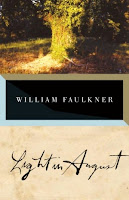 |
The courtroom of "To Kill a
Mockingbird" |
It was my birthday and we were headed for Mobile, Alabama. “There’s
a Carnival cruise ship there,” my husband, Wendy, said. “I hope you brought
your passport.”
“I bet you got a good price,” I teased. This was Day Two of
my five-day sixtieth birthday celebration and each day was a surprise. Wendy
would come to a corner or fork in the road and I would watch anxiously to see
which way we went, adjusting my guess based on the turn. I was having a blast.
At about eleven in the morning, he steered the VW into a
truck stop for a restroom break. Or so I thought. He didn’t get out of the car,
but instead handed me an envelope and said, “Here. This is your birthday gift.”
When I opened the card, I cried out with joy and gratitude.
Inside were two tickets to the local production of To Kill a Mockingbird that Monroeville, Alabama residents put on
each year. Monroeville is the home of reclusive author Harper Lee and the prototype
for much of the book—her only work and my very favorite book/movie.
I have read the book a handful of times, but I have seen the
movie too often to count. As a conflict resolution teacher, I used clips
from the film to show how Atticus would get spit in the face by Bob Ewell, wipe
his face and walk away—not in fear, but in courage. Never did I have a middle
schooler call Atticus a coward; they all recognized his dignity and valor. And when the
black townspeople at the courthouse rose in honor of Atticus after he defended
Tom Robinson, tears never failed to fall from my eyes. (During my single days,
I often said I’d like to marry Atticus. )
 |
I meant marry the Gregory Peck
version. |
We drove the twenty miles to Monroeville and had a look around.
The Old Courthouse Museum was where Lee’s father, the model for Atticus Finch,
practiced. This courtroom was studied and measured by set designers, then
re-created in Hollywood where the movie was filmed. Stepping into the actual
room was magical.
 |
No photography during the play,
so use your imagination. |
While we looked around, one of the curators asked Wendy if
he would like to be on the jury for the evening’s performance. They chose only
white men for authenticity. “Do it!” I urged. This could not get any better. Imagine him behind Gregory Peck, looking stern and disgusted with Tom Robinson.
Entering the courtroom, I sat in the witness chair,
channeling Mayella Ewell. “Your fancy airs don’t come to nothin’, Mr. Finch!”
 |
| Mayella on the stand |
 |
| Me on the stand |
I climbed into the balcony and crouched where Jem, Scout, and
Dill watched the trial with Reverend Sykes and the rest of the “colored”
community.

Outside the courtroom, encased in glass, is what’s left of
the tree that grew in front of the real-life Radley house. This was as close as
falling into a rabbit hole and landing in 1930’s Maycomb, Alabama, as one can
come. My whole body buzzed with excitement.
 |
Me as Mrs. Dubose: "Don't you say 'hey'
to me, you ugly girl!" |
In the evening, we sat outside the courthouse for the first act. An
amphitheater has recently been built where pre-trial scenes are enacted.
After
that, the court clerk and Sheriff Heck Tate announced those selected for the
jury. Wendy and his compatriots headed in the back way and I found a seat on
the jury side of the courtroom, second bench back. Right behind me sat “Miss
Maudie” and “Miss Stephanie” who whispered their gossipy comments throughout
the play. Only those within a couple-foot radius could hear them. It was so
cool!
Many of the local actors are related to, knew, or knew of
the actual people the book was based on. I was very impressed with the talent
of these volunteers, who have even taken the production around the world.
 |
| Atticus Finch Monument |
Atticus Finch, although fictional, is an American hero. In
Monroeville, the Alabama State Bar erected a memorial to him, calling him a “lawyer-hero.”
The American Film Institute named him the greatest film hero in the last 100
years. Over the last fifty years, this novel has affected people throughout the world the way it has inspired me and I was privileged
to feel a part of it.
































